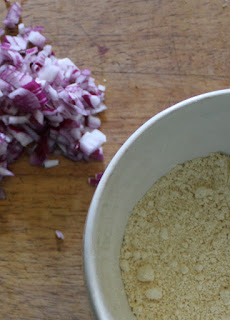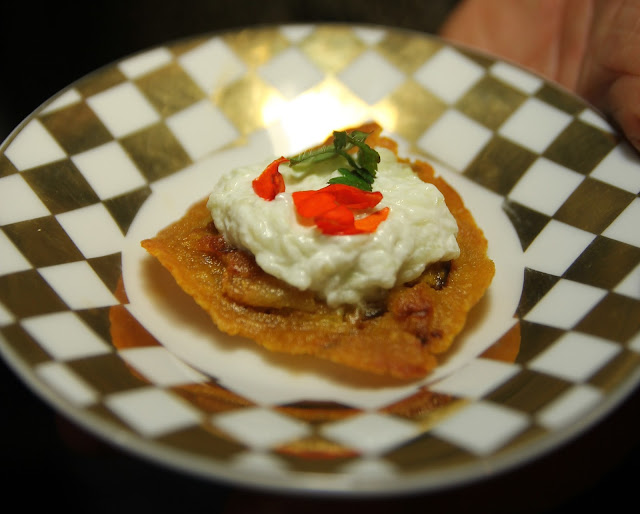We eat chickpea pancakes on a regular basis, they make a tasty accompaniment to all kinds of snacks, main course and supper dishes. I was intrigued to marry, what might be thought of as a distinctly Gujarati 'pudla' or pancake with a traditional cucumber meze but actually there is a tasty Greek pita bread made from chickpea flour.
Throughout the Mediterranean and Middle East, wherever chickpeas are grown there are a whole host of gluten-free flatbreads and wraps. The most famous of these perhaps is the Tuscan 'Cecina', a chickpea flour flat bread which is baked or shallow fried. Cecina is also found in the cuisine of the Côte d'Azur, in particular Nice and is said to date from Ancient Rome. It's a bread we have often in the Winter with soup when the temperatures begin to drop and I'll be posting the recipe soon!
Pudla is a traditional breakfast dish and we certainly eat chickpea pancakes this way but they also make a great lunch with a salad and in particular marry well with cucumber.
Throughout the Mediterranean and Middle East, wherever chickpeas are grown there are a whole host of gluten-free flatbreads and wraps. The most famous of these perhaps is the Tuscan 'Cecina', a chickpea flour flat bread which is baked or shallow fried. Cecina is also found in the cuisine of the Côte d'Azur, in particular Nice and is said to date from Ancient Rome. It's a bread we have often in the Winter with soup when the temperatures begin to drop and I'll be posting the recipe soon!
Pudla is a traditional breakfast dish and we certainly eat chickpea pancakes this way but they also make a great lunch with a salad and in particular marry well with cucumber.
 PUDLA
PUDLA
Ingredients
(makes 20)
140g (5oz) sifted chickpea flourA generous pinch of sea salt and black pepper
250ml water
5 cloves of garlic - finely chopped
1 medium (red) onion - ditto
1 teaspoon cumin seeds
1 teaspoon powdered turmeric
Oil or butter for cooking
Method
Put flour and sea salt and pepper into a bowl or jug. Slowly add the water whilst mixing, so as to form a smooth batter. Peel and finely chop the garlic and onion and add to mixture. Leave to stand for at least half an hour.
Dry fry the cumin seeds until they begin to crackle. Add them and the turmeric to the batter.
Melt cooking fat in a frying pan, I use certified sustainable organic palm oil or coconut oil that really enhances all the other flavours.
Depending upon the size of your pan, ladle in sufficient batter to form small thin pancakes, about 40mm (1½") diameter.
Leave to cook for approximately three minutes. Lift the edge of the pancake to test if it is cooked, it should be a golden brown in colour. Flip over but add additional fat to cook the second side.
Once cooked, set aside in a warming drawer or low oven. if you leave them long enough in the warming drawer, they will become delicately crispy and even more delicious! I discovered this by accident whilst making all this food last night and into the early hours of this morning!
TZATZIKI
Ingredients
1 CucumberGreek Yoghurt
1 clove of garlic (grated)
The juice of half a small lemon
Dill, lemon balm or fennel to taste
Nasturtium flowers (optional)
Method
Peel and then either grate or chop the cucumber very finely. With a sieve and your hand press down and remove as much liquid from the cucumber as possible.
Put in a cool place for the flavours to develop for at least an hour before use.
Serve pancakes just warmed, so that the cold Tzatziki makes even more impact but doesn't lose shape. This dish is however just as good cold!
Natural Colours and Flavours
Nasturtiums (Tropaeolum majus) come in many colours and shades and you can eat the flowers, leaves and make the seeds into substitute capers. I grow them all year round and one of my particular favourites is Jewel of Africa, which also comes in a variegated leaf version and looks fabulous in all sorts of dishes and as a cake decoration!

Lemon balm (Melissa officinalis), of the mint family and nasturtium are nutritious, delicious and decorative. Lemon balm as the name suggests is particularly good with fish. Lemon balm and nasturtium have been known and used as medicinals for centuries. Both plants are easy to grow and as mentioned above if you have a greenhouse or a warm south-facing wall or window sill you can grow nasturtiums and have them reseed and be in flower all year round.
Enjoy!
All that needs to be said now is Bon Appėtit!
Hope to see you here again for another recipe from an old farmhouse in Normandie,
All the best, Sue
RETURN TO MAIN CONTENTS PAGE
RETURN TO 100 GLUTEN-FREE PARTY RECIPES CONTENTS
© Sue Cross 2017








No comments:
Post a Comment